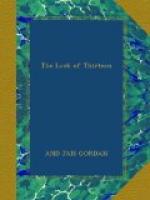[Illustration]
Miles and miles of walls with great doors. The main streets branch out into thousands of impasses each ending in a locked door. There are hardly any connecting streets, for somebody’s walled garden is between. The Mahommedans hide in seclusion on one side of the town, while their hated enemies the Christians live on the other. Each house, Turk or Christian, has the same air of defiant privacy, the only difference being that the Turk’s windows are blocked with painted lattice. The Mahommedan women’s faces are covered with several thicknesses of chiffon, generally black, while the Christian peasant women walk about with an eye and a half peering from the shrouding folds of a cotton head shawl which they hold tightly under their noses.
With difficulty we found the English consul’s house, as the Albanians speak no Serb and Montenegrins were not to be found at every street corner. At last we found it appropriately enough in the Rue du Consulat d’Angleterre. A gorgeous old butler resembling a wolf ushered us from the blank walled street into a beautiful square garden filled with flowering shrubs and creepers. Not to be outdone by the colours of the flowers, the butler was clad in a red waistcoat, embroidered with gold, a green cloth coat, blue baggy trousers, and a red fez with a tassel nearly a yard long, while a connoisseur’s mouth would have watered at the sight of his antique silver watch-chain with its exquisitely worked hanging blobs.
The interior of the house gave an impression of vast roominess. Wide stairs, a huge upper landing like a reception-room, a panelled drawing-room large enough to lose one’s self in, ornamented by primitive frescoes on the walls above the panels.
The English consul was an old Albanian gentleman with delightful manners. For a long time he had been suffering from an illness which had started from a wound in the head, received during the siege of Scutari. After the inevitable coffee and cigarettes his son wandered out with us and showed us the interesting parts of the town. Out of a big doorway came two women in gorgeous clothes. They had been paying a morning call, and bade farewell to their hostess. Doubtless they were mother and daughter.
One was faded and beautiful; the younger was of the plump cream and roses variety with modestly downcast eyes. Both wore enormous white lace Mary Queen of Scots’ veils, great baggy trousers made of stiff shiny black stuff, which was gathered into hard gold embroidered pipes which encased the ankles and upwards. These pipes were so stiff that they had to walk with straight knees and feet far apart. Their full cavalier coats were thickly covered with many kilometres of black braid sewn on in curly patterns, and the girl wore at least a hundred golden coins hung in semicircles on her chest.
They left the third woman at the door and walked back a few steps down the road, then turned, and laying hand on breast, bowed ceremoniously, first the mother, then the daughter, who never lifted her eyes; another twenty steps and again the same performance; still once more, after which they slowly waddled round the corner. Suma told us they wore the costume of the haute bourgeoisie, and probably the girl had been taken to see her future mother-in-law.




